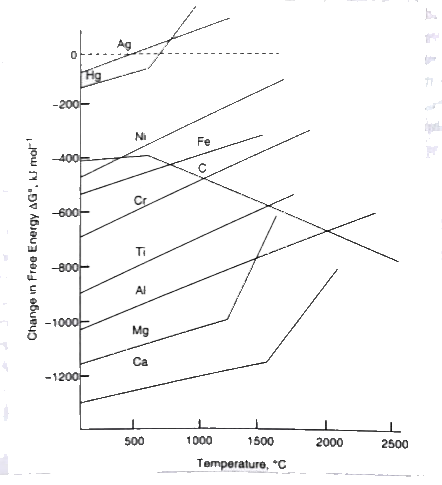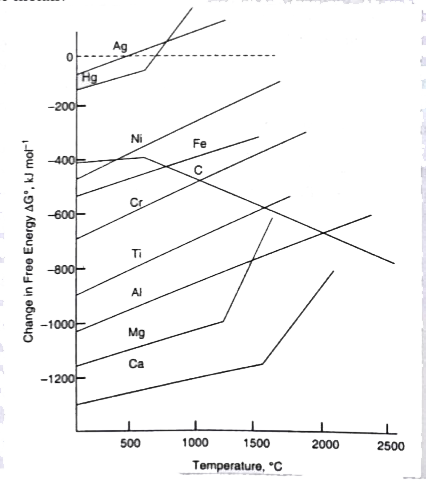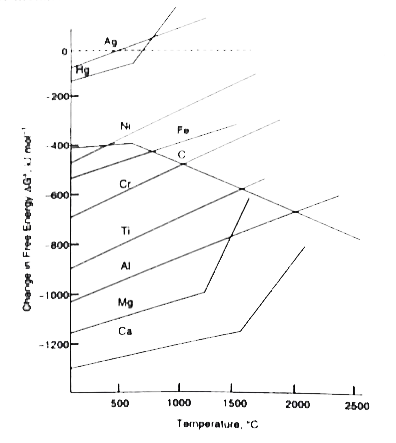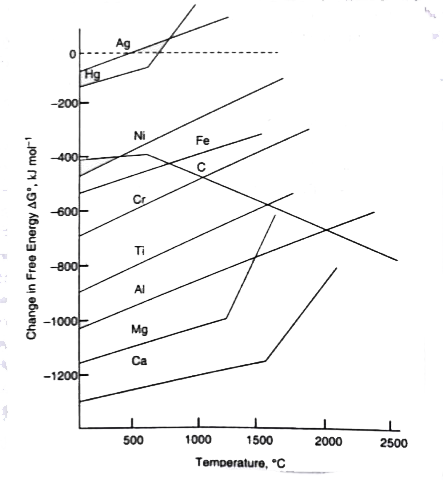Which statement is correct when adsorption of gas take place on metal surface?
(a) δH becomes less negative with pregress of reaction.
(b) with progress of reaction the strength of residual forces increases.
(c) NH3 is adsorbed more than N2.
(d) Equilibrium concentration of adsorbate increases with increase in temperature.
a,c
a,b
b,d
b,c
The correct Answer is:A
To solve the question regarding the correct statement when gas adsorption occurs on a metal surface, we will analyze each option step by step.
Step 1: Analyze Statement (a)
Statement (a): ΔH becomes less negative with the progress of the reaction.
- When a gas is adsorbed onto a metal surface, the randomness (entropy, ΔS) of the system decreases because the gas molecules become more ordered when they adhere to the surface.
- Since ΔG = ΔH - TΔS, a decrease in ΔS (which is negative) leads to an increase in ΔH (making it less negative).
- Therefore, this statement is correct.
Step 2: Analyze Statement (b)
Statement (b): With the progress of the reaction, the strength of residual forces increases.
- Residual forces refer to the unbalanced forces acting on the adsorbed molecules.
- As more gas molecules adsorb onto the surface, the forces acting on each molecule become more balanced, leading to a decrease in residual forces.
- Thus, this statement is incorrect.
Step 3: Analyze Statement (c)
Statement (c): NH3 is adsorbed more than N2.
- NH3 is a polar molecule, while N2 is a non-polar molecule.
- Polar molecules generally have stronger interactions with surfaces than non-polar molecules, leading to a higher rate of adsorption.
- Therefore, this statement is correct.
Step 4: Analyze Statement (d)
Statement (d): Equilibrium concentration of adsorbate increases with an increase in temperature.
- Adsorption is typically exothermic and decreases with an increase in temperature according to Le Chatelier's principle.
- Therefore, if temperature increases, the equilibrium concentration of the adsorbate will decrease.
- Thus, this statement is incorrect.
Conclusion
The correct statements are (a) and (c).
Final Answer
The correct options are (a) and (c).
---
Statement (a): ΔH becomes less negative with the progress of the reaction.
- Since ΔG = ΔH - TΔS, a decrease in ΔS (which is negative) leads to an increase in ΔH (making it less negative).
- Therefore, this statement is correct.
Statement (b): With the progress of the reaction, the strength of residual forces increases.
- As more gas molecules adsorb onto the surface, the forces acting on each molecule become more balanced, leading to a decrease in residual forces.
- Thus, this statement is incorrect.
Statement (c): NH3 is adsorbed more than N2.
- Polar molecules generally have stronger interactions with surfaces than non-polar molecules, leading to a higher rate of adsorption.
- Therefore, this statement is correct.
Statement (d): Equilibrium concentration of adsorbate increases with an increase in temperature.
- Therefore, if temperature increases, the equilibrium concentration of the adsorbate will decrease.
- Thus, this statement is incorrect.
The correct statements are (a) and (c).
The correct options are (a) and (c).
Similar Questions
A reaction N2+3H2⇔2NH3+92k.j is at equilibrium. If the concentration of N2 is increased the temperature of the system
View SolutionFor the reaction
5Br−(aq)+BrO−3(aq)+6H+(aq)→3Br2(aq)+3H2O(l)
the reate expression was found to be −d[BrO3−]dt=k[Br−][H+]2[BrO−3]
Which of the following statements is /are correct?
I. Doubling the intial concentration of all the reactants will increase the reaction rate by a factor of 8.
II. Unit of rate constant of the reaction in a buffer solution is min−1
III. Doubling the concentration of all the reactants at the same time will increase the reaction rate by a factor of 16
IV. rate of conversion of BrO−3 and rate of disappearance of Br− are the same
View Solution
Knowledge Check
Which of the following statement is correct? A)The rate of a reaction decreases with passage of time as the concentration of reactants decreases. B)The rate of a reaction is same at any time during the reaction C)The rate of a reaction is independent of temperature change D)The rate of a reaction decreases with increase in concentration of reactant(s)
AThe rate of a reaction decreases with passage of time as the concentration of reactants decreases.BThe rate of a reaction is same at any time during the reactionCThe rate of a reaction is independent of temperature changeDThe rate of a reaction decreases with increase in concentration of reactant(s)The correct statement(s) pertaining to the adsorption of a gas on a solid surface is(are)
(i) adsorption is always exothermic
(ii) physisorption may transform into chemsisorption transform into chemisorption at high temperature
(iii) physisorption increases with increasing temperature but chemisorption decreases with increasing temperature .
(iv) chemisorption is more exothermic than physisorption , however it is very slow due to higher energy of activation.A(i) and (iv) onlyB(ii) and (iii) onlyC(i),(ii) and (iv) onlyDAll of these.
which statement is/are correct for this reaction?
(I) polarity of solvent decreases then rate of reaction increases.
(II)strong nucleophilie is more suitable for this reaction.
(III) if R is bulky then carbocation become more stable.
(iv) racemisation take place in this reaction.
View SolutionWhich of the following factors will increase the solubility of NH3 gas in H2O?
a. Increase in pressure
b. Addition of water
c. Increase in temperature
d.Decrease in pressure
View SolutionFor a sponaneous reaction, the free energy change must be negative, ΔG=ΔH−TΔS,ΔH is the enthalpy change during the reaction. T is the absolute temperature, and ΔS is the change in entropy during the reaction. Consider a reaction such as the formation of an oxide
M+O2→MO
Dioxygen is used up in the course of this reaction. Gases have a more random structure (less ordered) than liquid or solids. Consequently gases have a higher entropy than liquids and solids. In this reaction S (entropy or randomness) decreases, hence ΔS is negative. Thus, if the temperature is raised then TΔS becomes more negative,Since, TΔS is substracted in the equation, then ΔG becomes less negative. Thus, the free energy change increases with the increase in temperature.
The free energy changes that occur when one mole of common reactant (in this case dioxygen) is used may be plotted graphically aginst temperature for a number of reactions of metals to their oxides. The following plot is called an Ellingham diagram for metal oxide. Understanding of Ellingham diagram is extremely important for the efficient extraction of metals.

Which of the following elements can be prepared by heating the oxide above 400∘C ?
View SolutionFor a sponaneous reaction, the free energy change must be negative, ΔG=ΔH−TΔS,ΔH is the enthalpy change during the reaction. T is the absolute temperature, and ΔS is the change in entropy during the reaction. Consider a reaction such as the formation of an oxide
M+O2→MO
Dioxygen is used up in the course of this reaction. Gases have a more random structure (less ordered) than liquid or solids. Consequently gases have a higher entropy than liquids and solids. In this reaction S (entropy or randomness) decreases, hence ΔS is negative. Thus, if the temperature is raised then TΔS becomes more negative,Since, TΔS is substracted in the equation, then ΔG becomes less negative. Thus, the free energy change increases with the increase in temperature.
The free energy changes that occur when one mole of common reactant (in this case dioxygen) is used may be plotted graphically aginst temperature for a number of reactions of metals to their oxides. The following plot is called an Ellingham diagram for metal oxide. Understanding of Ellingham diagram is extremely important for the efficient extraction of metals.

Free energy change of Hg and Mg for the convertion to oxides the slpe of ΔG vsT has been changed above the boiling points of the given metal because :
View SolutionFor a sponaneous reaction, the free energy change must be negative, ΔG=ΔH−TΔS,ΔH is the enthalpy change during the reaction. T is the absolute temperature, and ΔS is the change in entropy during the reaction. Consider a reaction such as the formation of an oxide
M+O2→MO
Dioxygen is used up in the course of this reaction. Gases have a more random structure (less ordered) than liquid or solids. Consequently gases have a higher entropy than liquids and solids. In this reaction S (entropy or randomness) decreases, hence ΔS is negative. Thus, if the temperature is raised then TΔS becomes more negative,Since, TΔS is substracted in the equation, then ΔG becomes less negative. Thus, the free energy change increases with the increase in temperature.
The free energy changes that occur when one mole of common reactant (in this case dioxygen) is used may be plotted graphically aginst temperature for a number of reactions of metals to their oxides. The following plot is called an Ellingham diagram for metal oxide. Understanding of Ellingham diagram is extremely important for the efficient extraction of metals.

For the conversion of Ca(s) to Ca(s) which of the following represent the ΔG vs. T ?
View SolutionFor a sponaneous reaction, the free energy change must be negative, ΔG=ΔH−TΔS,ΔH is the enthalpy change during the reaction. T is the absolute temperature, and ΔS is the change in entropy during the reaction. Consider a reaction such as the formation of an oxide
M+O2→MO
Dioxygen is used up in the course of this reaction. Gases have a more random structure (less ordered) than liquid or solids. Consequently gases have a higher entropy than liquids and solids. In this reaction S (entropy or randomness) decreases, hence ΔS is negative. Thus, if the temperature is raised then TΔS becomes more negative,Since, TΔS is substracted in the equation, then ΔG becomes less negative. Thus, the free energy change increases with the increase in temperature.
The free energy changes that occur when one mole of common reactant (in this case dioxygen) is used may be plotted graphically aginst temperature for a number of reactions of metals to their oxides. The following plot is called an Ellingham diagram for metal oxide. Understanding of Ellingham diagram is extremely important for the efficient extraction of metals.

As per the Ellingham diagram of oxides which of the following conclusion is true ?
View Solution
